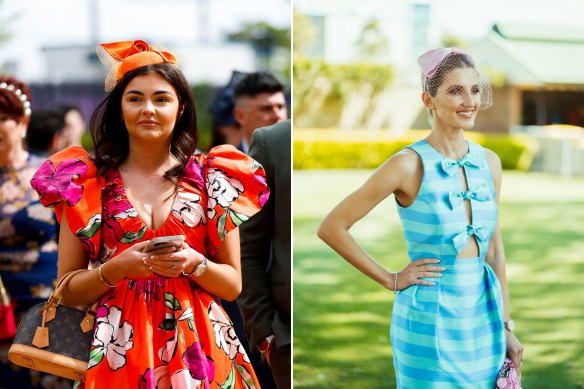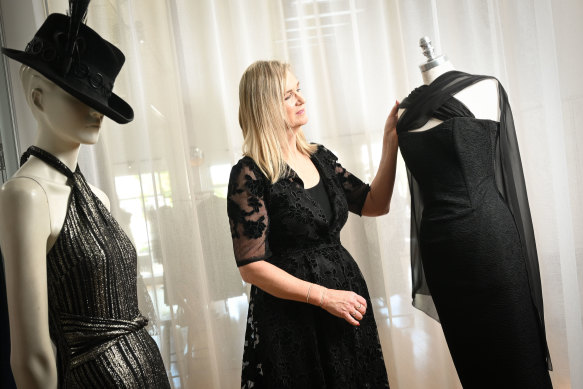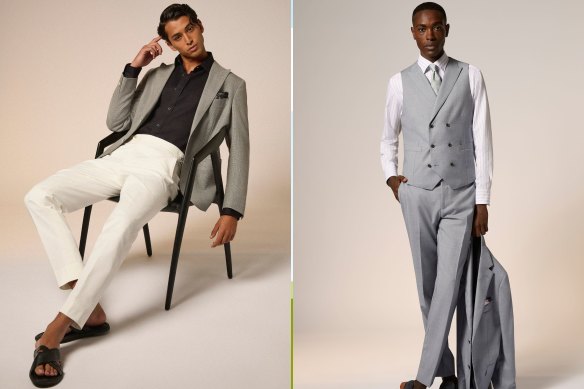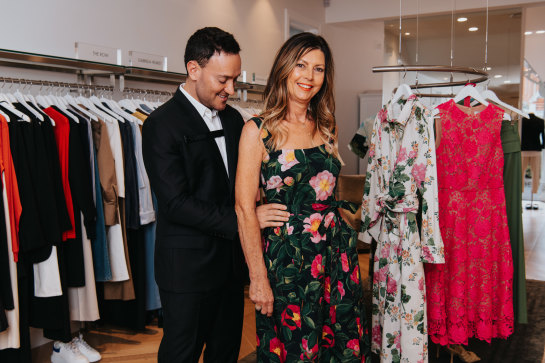‘Racing is a risk’: Designers and retailers are taking a new approach to racewear
Save articles for later
Add articles to your saved list and come back to them any time.
Every Melbourne Cup there’s a look – a dress, suit or shoe – that defines the season. Last year, it was arguably an orange puffed-sleeve dress by Australian brand Aje. This spring, one early contender is a mini-dress with bow and cutout detail in shades of lemon, cherry or aqua by Rebecca Vallance.
The dresses have already popped up trackside on racing identity Kate Waterhouse at the Everest, and stylist Lana Wilkinson at Caulfield. But Vallance insists it’s a happy accident, saying she doesn’t design with the races specifically in mind, nor does she explicitly promote them.
Fashion favourites … a racegoer in Aje in 2022 (left), and Kate Waterhouse wearing Rebecca Vallance at the Everest.Credit: AAP/Dion Georgopoulos
“It’s not racing specific as such,” Vallance says. “The reason we dress so many people at this time of year is people like to [wear things] with nods to the dress codes.”
Placing a dress or hat on a celebrity – especially an international one – on Derby Day or Melbourne Cup can translate into a massive marketing opportunity for brands, and kickstart the crucial Christmas trading period. However, thanks to the combined forces of falling attendance numbers, cost-of-living pressures and Gen Z’s apathy or opposition to horseracing – on a variety of grounds, including but not limited to animal welfare concerns – fashion brands are far less focused on racewear than they were a decade ago.
Disregarding the key pandemic years, when the races were either held without spectators or with limited live audiences, the value of retail investment has dropped from nearly $63 million in 2018, to $52 million last year, according to a Victoria Racing Club economic impact study. However, according to racing insiders, who were not authorised to speak publicly, those who do attend are spending more per person. Still, the overall pie is shrinking.
As an ethically minded racegoer, designer Lisa Barron says fashion brands can absolutely cater for racing, while also demanding the industry lifts its game. “You have to be blind not to know animal welfare is a huge area of concern,” says Barron. “Awareness is everything. I’m not afraid to say what I feel, and in my social media, at times I have been clear where I stand on animal cruelty.”
Designer Lisa Barron, in her Melbourne boutique, has diversified her business as demand for pure racewear has dropped.Credit: Eddie Jim
Barron, whose business has been based on Melbourne’s fashionable High Street for 30 years, says the decision to pare back on racewear in her collections is as much about good financial sense as any moral imperative. Gone are the days her clients – mostly professional women over 40 – would come in to buy four outfits (one for each day at the track).
“Because the racing component [of our business] isn’t as large any more, we have grown business-wear, event and wedding wear – that’s probably our core business now,” she says. “And a lot of those pieces can cross over and be worn to both. As long as it doesn’t sparkle, you can wear it to the races.”
Risk or reward
Speaking to key industry players, it’s clear the relationship between fashion and racing in 2023 is more complex than it was in 2019, when an ABC Four Corners episode, aired on the eve of the spring carnival, focused on allegations of cruelty against racehorses.
One senior PR executive, who spoke on condition of anonymity, says many models and creatives will no longer take racing-themed jobs. Some brands, such as Melbourne-based vegan shoe label TWOOBS, have actively boycotted racing. But far more have taken a subtler approach, by removing references to racing in their marketing or by declining to loan product to celebrities or influencers attending the track.
For high-street brands, the welfare debate surrounding racing, as well as the financial constraints on customers and concerns over sustainability are all reasons companies have pulled back on designs that are too racewear specific.
Carolyn McKenzie, managing director at Forever New, says the company now prefers a more holistic approach. Still, for those who are keen, there’s a “racing” tab on its website, and there are still headbands and “racing adjacent” designs. “We’ve moved away from ‘racing’ promotion to ‘event’ promotion,” McKenzie says. “Being too attached to racing is a risk.”
Michal Carrington, associate professor of marketing at the University of Melbourne, agrees brands need to weigh the risks of an attachment to racing from multiple perspectives – gambling, animal welfare, cost of living and sustainability – against the potential commercial gain.
“As a brand, it doesn’t mean you [shouldn’t] partner with those organisations that have concerns [around them],” she says. “But you also look to ensure [you’re contributing to] the betterment of this industry rather than being complicit.”
Of course, when it comes to racing, she says, there will be businesses that stay away because an association is “so incongruent” with their brand identity. “But there will be organisations that keep their toe in the water to see what the public sentiment is over time,” she says. “These things can be cyclical.”
‘We focus on what we do best’
Another brand treading softly in the racing space is menswear label MJ Bale. Founder and director Matt Jensen says he accepts that hundreds of thousands of people still attend the races, and they may all need something to wear. If anything, he’s taking a sustainability focused approach to races dressing, by encouraging men – especially those not bound by members’ dress regulations – to embrace “hybrid” dressing, blending casual and formal.
In general admission, this could mean a knitted polo with a pair of chinos. The idea, of course, being that the purchases have uses well beyond race day.
MJ Bale’s ‘hybrid’ racewear (left), and a more traditional approach.
“It’s important to be relevant to what our customer is actually doing,” he says. “It’s important to communicate it clearly. Whether you have a view one way or another on racing, what we’re trying to do is talk about the occasion … that’s formal or informal, work or play.”
Belinda International’s Joshua Penn (with store manager Jacqueline DiMicco, in Oscar de la Renta): “I don’t want [Belinda] to be known as somewhere you just go for one specific dress.”Credit: James Brickwood
At the luxury end of fashion, retailers can’t afford to be one-eyed about racing and pieces need to have multiple uses, says Joshua Penn, who, together with Jackie Yencken, co-owns Belinda International.
Penn says he buys stock for the Sydney and Melbourne boutiques from brands including Victoria Beckham and Oscar de la Renta with the races in mind, but doesn’t market it too heavily, mainly for sustainability reasons. “I don’t want [Belinda] to be known as somewhere you just go for one specific dress that you wear once,” he says.
He acknowledges the need to respect different clients’ views and the cultural pulse. “A lot of our clients don’t love the idea of horses being [bred for racing] but I don’t think it is bad to celebrate togetherness, especially at times like these,” he says.
“It’s hard in these political times to take a side, and as much as you sometimes want to take a stand you have to be conscious that you have a business … We just focus on what we do best.”
Make the most of your health, relationships, fitness and nutrition with our Live Well newsletter. Get it in your inbox every Monday.
Most Viewed in Lifestyle
From our partners
Source: Read Full Article



